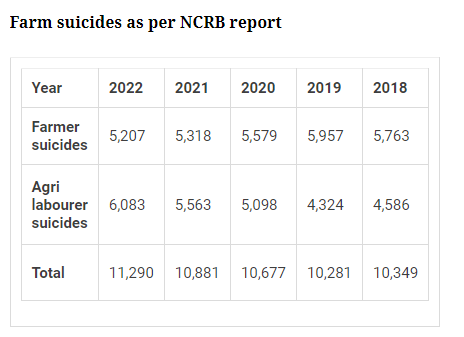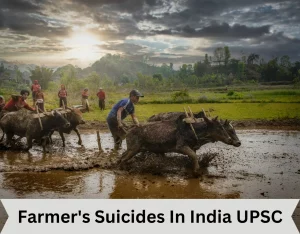ForumIAS announcing GS Foundation Program for UPSC CSE 2025-26 from 19 April. Click Here for more information.
According to the National Crime Reports Bureau (NCRB) report 2022, 11,290 cases of farmer’s suicides were reported in 2022. There has been a 3.75% rise in the cases of farmer’s suicides, from the 10,881 suicides reported in 2021. The situation has been particularly grim in Maharashtra, which accounts for 38% of all suicides in the agricultural community. Farmer’s Suicides In India UPSC

What are The Reasons of Farmer Suicides in India?
1. Debt Trap- Debt trap is a major cause of farmer suicide in India due to crop failure and rising indebtedness.
2. Lack of access to formal credit- There is low access to formal credit agricultural credit in India. The easy availability of informal credits, sahukars (moneylenders) which provide instant loans at very high interest rates of 30% to 40%, adds on to the burden of already aggrieved farmers.
3. Change in Cropping Patterns- There has been change in cropping patterns in the arid regions of the country. For ex- Change in the crop patterns in arid regions of Marathwada and Rayalaseema from millets (suited for arid regions) to cotton and sugarcane (unsuitable for arid regions).
4. Unproductivity of agriculture- The increase of input costs like seeds, fertilizers, and pesticides and lack of commensurate price of final agricultural produce has made the agriculture sector unproductive. For Ex- In the Marathwada region, the production cost of cotton ranges between ₹6,500 and ₹7,000 per quintal, while the current market price hovers around ₹6,800 which makes it challenging for farmers to break even.
5. Climate Change- Climate change has led to erratic monsoons, shrinking of water resources and increased pest attacks incidents which has made agriculture unproductive and has driven farmers to suicides.
6. Socio-cultural Issues- Socio-cultural challenges like loans for marriages for fulfilling social obligations like dowry, spendings on weddings, drug abuse/alcoholic addiction are major reasons for suicides in India.
7. Lack of access to schemes- Landless agricultural labourers have not been benefitted from income support schemes such as PM Kisan.
8. Mental health- Mental depression due to fear of boycott due to societal pressures is also a major reason for suicide in India.
What are The Ramifications of Increasing Farmer’s Suicide?
1. Failure of ‘Agriculture as an enterprise’- Suicides of farmers lead to a loss of productivity in the agricultural sector, affecting overall food production. The increase in farmer’s suicides reflects the failure of our aim of doubling farmer’s income by 2022. These factors have led to failure of ‘agriculture as an enterprise‘.
2. Negative Impact on Rural Economic growth- Suicides of farmers trigger an economic ripple effect and leads to dampening of economic growth of rural businesses and communities.
3. Social Consequences- The suicide of a farmer often leaves the family in emotional and financial distress, with widows and children bearing the brunt of the aftermath.
4. Mental Health challenges among the farmers- The pervasive issue of farmer suicides contributes to mental health challenges in farming communities. Some farmers resort to substance abuse as a coping mechanism, exacerbating mental health challenges.
5. Global Trade and Market Dynamics- Changes in Indian agriculture, influenced by farmer suicides, can have repercussions on global commodity markets. It is also a blot on India’s dream of becoming a $5 tn dollar economy.
| Read More- What is Farmer’s Distress Index? |
What are The Government Initiatives to Reduce Farmer Suicides in India?
| Pradhan Mantri Fasal Bima Yojana (PMFBY) | PMFBY is a crop insurance scheme aimed at providing financial support to farmers in the event of crop failure, helping to reduce the economic burden on them. |
| Pradhan Mantri Kisan Samman Nidhi (PM-KISAN) | PM-KISAN is a direct income support scheme that provides financial assistance to eligible farmers in the form of direct bank transfers. |
| Agricultural debt waiver and debt relief Scheme, 2008 | Agricultural Debt Waiver and Debt Relief Scheme in 2008 benefited over 36 million farmers at a cost of 65000 crore rupees (US$10 billion). This spending was aimed at the writing of part of loan principal as well as the interest owed by the farmers. |
| Loan Waiver Schemes | State governments have occasionally announced loan waiver schemes to alleviate the debt burden on farmers. These schemes aim to provide relief and prevent farmers from falling into a debt trap. For ex- Rajasthan and Chhattisgarh loan waiver schemes. |
| National Mission for Sustainable Agriculture (NMSA) | NMSA focuses on promoting sustainable agricultural practices, improving water-use efficiency, and supporting climate-resilient agriculture. |
What Should be The Way Forward?
1. Financial Support and Debt Relief- Explore sustainable and targeted debt relief mechanisms to alleviate the burden of high-interest loans. For ex- Proper Implementation of crop insurance schemes.
2. Diversification of Agriculture- Promotion of crop diversification to reduce dependency on a few crops (like cotton and sugarcane in arid regions) and enhance resilience to market fluctuations and environmental challenges.
3. Market Reforms- Implement market reforms to ensure fair prices for agricultural produce and reduce the influence of middlemen. For ex- Strengthen and expand online trading platforms like e-NAM.
4. Mental Health Support- Address the mental health stigma in rural areas and establish mental health support systems for farmers. For ex- Counselling services and awareness programs.
5. Research and Innovation- Invest in agricultural research and innovation to develop new technologies, resilient crop varieties, and sustainable farming practices. For ex- Development of drought resistant GM crops.
| Read More- The Hindu UPSC Syllabus- GS 3- Indian Agriculture Challenges |





